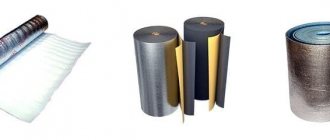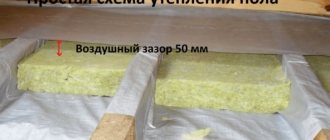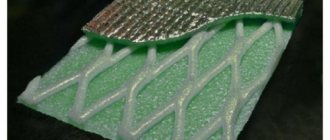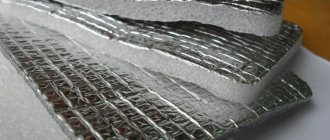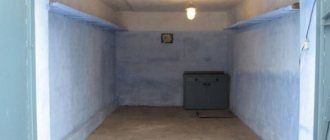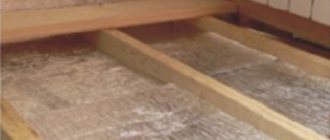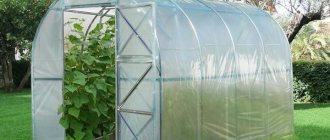Frequent mistakes and advice from experts on installing insulation
A common mistake when insulating a wooden ceiling with isolon from the inside is that the strips of material are laid with an overlap.
This cannot be done, because condensation will form between two layers without an air gap. Strips of foil insulation are laid only joint to joint. All seams must be taped with reinforced tape. You can use silicone sealant instead. https://youtube.com/watch?v=RgKvM3-JFRU
Do not connect the insulation to the wall surface. It is placed on the walls to a height of 10-15 cm. Also, the foil side of the insulating material must not come into contact with the power supply wires. Since aluminum conducts electricity well, the junction points with the wiring are carefully insulated.
If penofol or isolon is used as an independent insulation, then choose the thickest type of material that has a double-sided foil layer. If the temperature behind the insulated surface drops below zero, then foamed polyethylenes are used only in conjunction with other more effective heat insulators.
Choosing a heat insulator
If we are talking about thermal insulation, then you should not save on insulation. You should purchase only high-quality materials for floor insulation in a wooden house.
Ideally, the floor temperature in the room should be slightly lower than the general temperature. Therefore, if low-temperature coatings are used, condensation may form on them.
Rolled mineral wool.
As a result, a humid environment promotes the growth of mold and mildew. In addition, a good thermal insulator must have high compressive strength and low density during deformation, since most mechanical loads will fall on it.
Types of thermal insulation materials
Insulating a wooden floor in a private house requires the installation of high-quality insulation, since there are always small gaps between the boards through which the cold penetrates into the room. Therefore, the insulation must be laid in a continuous layer.
Today the following materials have the best characteristics:
- Styrofoam. For a long time, this material has been the leader in the heat insulator market. Today, the main competitor of polystyrene foam is mineral wool, which has several important advantages over this material.
The main advantages of polystyrene foam
- Excellent thermal insulation.
- Biological stability.
- Stability of shape and volume.
- High moisture resistance.
- Low vapor permeability.
- Easy to install with your own hands.
- Environmentally friendly, does not emit harmful substances into the environment.
Styrofoam.
Flaws
- Poor sound insulation.
- Service life is no more than 20 years.
- It is flammable and releases harmful substances when burned.
- Acceptable price.
- Wide range of sizes. In addition, there is both slab and more flexible rolled material.
- Excellent heat and sound insulation.
- Fire safety.
- Easy to install.
- Service life is about 30 years.
- Mineral wool. Very often, the insulation of the floor of a wooden house is made with this material. Moreover, in addition to floor coverings, mineral wool is also used for walls, ceilings, balconies, etc., since it is a universal heat insulator.
Advantages of mineral wool
Slab mineral wool.
- Penofol is a thin insulation material that has unique properties. Due to the presence of a foil side, this material can be used as a waterproofing material, while possessing high thermal insulation characteristics. Penofol insulation is most often used in cases where it is necessary to lay as thin a layer of thermal insulation as possible (internal wall insulation). As a replacement for this heat insulator, insulation is often carried out with isolon, which has similar characteristics.
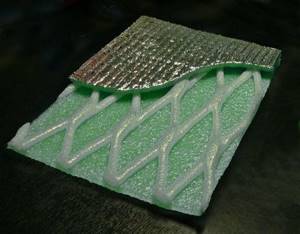
Penofol structure.
Scope of application of penofol
Even when used in a private home, this material can be used quite widely. Let's study the list of main directions.
Insulating a wooden floor with your own hands
Penofol is quite often used for insulating floors in wooden buildings. The process is as simple as possible, and it is quite possible to do it yourself. You just need to strictly follow a simple algorithm:
- Dismantle the old plank floor covering and lay penofol in the space between the joists in several layers. Each layer should be laid with the foil side inside the room. After this, you can mount the old boards in place or lay down the plywood sheets.
- In another case, you can lay the insulation directly on top of the wooden base. Then the insulation is laid in one layer, the material fragments are placed end to end. The seams are sealed using aluminum-based tape. Plywood is laid on top of the equipped thermal insulation layer. It is attached to the wooden base of the floor with self-tapping screws.
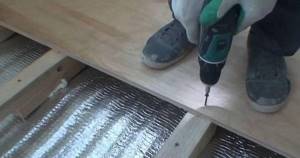
ATTENTION! It is not recommended to attach penofol to a wooden base using mechanical methods, such as staples from a construction stapler. If the insulation needs to be securely fixed, it is better to give preference to a variety with a self-adhesive base or coat penofol with special glue for better adhesion.
Thermal insulation of concrete floors
Most often, the use of penofol for thermal insulation of concrete floors in houses or balcony slabs occurs in tandem with other insulating materials. The work algorithm in this case will look like this:
- The concrete base must be thoroughly cleaned of debris and the surface properly leveled. For these purposes, it is better to use a self-leveling type of screed or a mixture with a self-leveling effect.

- Penofol is laid on top of the dried base. It is recommended to prefer a material in which both sides are foil. The seams are laid end-to-end with mandatory sealing with metallized tape.
- Then the frame is assembled from wooden elements. Bars with a cross-section of at least 5*5 centimeters are suitable.
- After this, you need to fill the space of the wooden sheathing with the selected insulation. This can be mineral wool, polystyrene foam and other materials.
- Now we begin laying the second layer of penofol. In this case, it is advisable to use material with foil on only one side. Metallization should “look” into the room.
- The final stage of insulating the concrete base is laying wooden flooring or plywood sheets on top of the joists.
Advantages and disadvantages of penofol insulation
The advantages of penofol as insulation include:
- Environmental friendliness of the material. The main components of penofol are aluminum and polyethylene, the non-toxicity of which has long been proven.
- Thickness. Penofol is a fairly thin material. This feature allows you to save as much space as possible.
- Low level of vapor permeability. Thanks to this feature, when installing penofol, the use of a vapor barrier layer is not required.
- Fire safety. Penofol is difficult to ignite and flammable.
- High level of sound insulation.
- Easy to install. Working with this material does not require any special clothing or special tools. Penofol is easy to cut with a knife; it does not crumble or break.
- Ease of transportation. Penofol is supplied in compact rolls that are easy to transport by regular car or transport.
In addition to an impressive list of advantages, penofol, like any other material, has its downsides:
- Soft material. Given this feature, penofol is not used, for example, under plaster finishing.
- Difficulties in fastening. It is undesirable to nail this material, except type C penofol, to the surface, as its thermal insulation properties may deteriorate. Installation is best done using special adhesives.
Types of penofol

Let's consider the main types of this material:
- Type A. This type of foam foam must be used in conjunction with another type of insulation. The aluminum coating is on the surface of only one side.
- Type B. Can be used without an additional layer of insulation. Both sides of the material are covered with aluminum foil.
- Type C. Installed without the use of other types of insulation. One side is aluminum, the other is polyethylene with a self-adhesive layer.
- ALP type. One side has an aluminum coating laminated with a layer of polyethylene.
- Type R and M. A type of penofol, characterized by a relief structure. Only one side is coated with aluminum.

Penofol laying technology
To understand how to insulate an old floor with penofol correctly, you need to study the technology for laying this material:
- You need to start working by choosing the type of material and becoming familiar with the features of its installation. For example, types A and C are laid under the finished floor. And when installing a heated floor system, it is better to use the ALP type.
- When the material has been selected and prepared, we proceed to pouring and leveling the floor with a concrete screed, after which all dirt and dust are removed from the surface.
- Next, the foam foam is laid end-to-end or with a slight overlap and the seams are taped.
- To prevent the formation of condensation, it is necessary to fill slats or logs 1.5 - 2 cm thick on top of the material. Thus, the necessary space for ventilation will be created between the insulation and the hard surface of the floor.
- Boards are laid perpendicular to the slats or joists, and on top of them are sheets of plywood or other hard material for the subfloor.
- Any floor covering is installed on top of the subfloor.
Tips for laying penofol

Connecting seams with aluminum tape
If you follow certain nuances, you can avoid many mistakes made when laying penofol. Here are the main ones:
- the foil layer of insulation must be laid in the direction of the heat source;
- to obtain the strongest effect of heat reflection on both sides of the insulation, you need to leave a free space of 1.5 - 2 cm;
- To achieve better sealing of the insulation, all seams must be connected with special aluminum tape.
Due to its excellent characteristics, penofol deserves special attention when choosing insulation for your home. Due to its reflective properties, penofol is a unique material for insulating floor surfaces.
Laying technology using lags
To insulate the floor in a wooden house, the first step is to make an expanded clay concrete base. To do this, you will need to distribute the expanded clay between the beacons and then fill everything with cement laitance. This is necessary to ensure that the building materials adhere to each other. After screed work, you can walk 24 hours later.
There is an alternative solution. You can lay 5-10 cm of foam plastic on the floor. Then we treat the surface with glue and lay penofol. A and C are suitable for these purposes. The device must be made with a slight overlap on the wall, about 10 centimeters. Penofol joints are glued with aluminum tape.

Due to its high moisture resistance, condensation may form on the surface of penofol. To avoid this, you need to leave space between the material and the floor. To do this, logs measuring 1.5 or 2 centimeters are attached to the foil side. This will be quite enough for ventilation.
The logs are installed level, bending them is not allowed, we lay plywood 12 millimeters thick on top. It is also possible to use 6 or 8 centimeter plywood, but this will require laying in two layers.
Thermal insulation of a wooden floor can be done on a rough surface. To do this, the coating is pre-treated with antiseptic agents or drying oil. After this, we put penofol end-to-end, glue it with aluminum tape, and cover it with plywood, which is screwed with self-tapping screws.
What to glue it with?
A correctly selected adhesive solution for foil material does not yet guarantee a successful installation. For a quality connection of materials, it is necessary that the surface to be glued be carefully prepared. All defects, irregularities, and various debris must be eliminated.
Concrete floors and walls are leveled, cracks are sealed, and metal products are treated with an anti-corrosion agent.
Adhesive for foil insulation can be either specialized or universal. You can also use liquid nails, double-sided tape, or a thin layer of foam. The choice of glue depends entirely on the purpose of the surface and its further use.
The adhesive composition must correspond to the performance indicators of the insulating material:
- permission for indoor use;
- the toxicity of the solution should be 0;
- high resistance to adhesion;
- the glue must withstand temperatures in the range of -60 to +100 degrees.
In order for penofol to be reliably glued to the surface, the glue must be applied to the side that does not have a foil layer. The adhesive solution is applied evenly, without gaps. The edges of the panel are carefully coated with glue so that the foil material does not come off during operation.
Before you start fixing the penofol, you need to wait 5-60 seconds for the glue to dry slightly. This ensures better adhesion to the products. Penofol is pressed to the surface, holding it, and smoothed out with special care.
Penofol laying technology for heated floors
If you plan to screed the heated floor and install tiles, then ALP type penofol is suitable. After installing the insulation, heating elements are laid on it, then reinforcing mesh, after which you can begin screeding. After complete drying, the protruding edges must be trimmed. The next step is to turn on the heating elements for a few days to improve the drying process. After the floor has dried, you can begin the process of installing the decorative covering.
The modern market of construction materials offers a significant range of different insulation materials, differing in degree of efficiency. One of the representatives of the new generation of heat insulators can be called penofol. With its help, you can easily insulate any surface in the house, be it the ceiling, walls or floor. Due to the fact that this material is produced using a special technology, it has high heat-saving qualities and other valuable characteristics.
Instructions for forming hydro- and vapor barriers
Waterproofing
- Mount the rough base. Carefully place a moisture barrier film on top of it.
- Lay the material in exact accordance with the contours of the insulated structure. As a result, there will be enough free space between the lags for laying insulation.
- When laying the canvas, make sure that the resulting overlap is at least 12 cm.
- Also check that the waterproofing material on the wall side reaches a height of approximately 20 cm.
- Protect the joints with reinforced tape, connecting them on both sides.
Vapor barrier
This task is performed after laying the thermal insulation layer
If mineral wool is used, it is important that there are no gaps in the cells. When laying expanded polystyrene and polystyrene foam, no reserve is left; the slabs are cut exactly to the size of the cells
After installation is completed, to increase the reliability of the insulation, the seams are filled with polyurethane foam.
Vapor barrier is performed in this way:
- install a protective membrane on top of the heat-insulating layer;
- securely attach the film along the joists and perimeter using staples;
- Attach counter slats (elements in the form of bars) along the wooden logs, which will become the basis for the floor covering;
- Attach sheet material, such as plywood, across the surface of the slats. As a finishing coating, you can use any material taking into account your own preferences, for example, linoleum, laminated flooring or parquet.
Examples of incorrect and dangerous use of Penofol
- Laying Penfol under a cement (reinforced concrete) screed. The foil is destroyed by the alkaline aggression of concrete, the insulation layer is compressed excessively. There is no warming effect.
- The use of Penofol as the main insulation layer in structures that must be insulated in accordance with standards - in floors, in roofs, in walls. In this case, users are usually guided by the assurances of sellers that the material replaces “5 centimeters of polystyrene foam” or “6 centimeters of mineral wool.” As a result, without a main insulating layer (in most cases, 10 cm of effective insulation is economically optimal...), the structures remain cold.
- Application from the side of the living space directly onto Penofol, without leaving an air gap, finishing panels, wooden finishing, wood structures, which entails dampening of the finishing, mold development, wood rotting due to condensation accumulated on the vapor barrier insulation. After a year of such use, according to the owners, Penofol is “black with mold.”
- Laying inside panel structures along the foil side of the electrical wiring.
- Joining Penofol sheets leaving gaps, which, in addition to a general reduction in insulation, in some structures leaves greater air permeability (drafts), which completely eliminates the presence of an insulating layer.
Use in a heated floor system
The combined use of these two insulation materials allows you to increase the amount of stored heat by 20%.
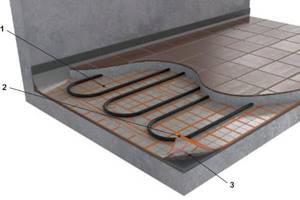
The method for laying ponofol with heated floors looks like this:
- Cover the cleaned surface with a concrete screed mixed with expanded clay and let it dry completely;
- Lay the sheets of penofol (“A”, “C”, “Alp”) with the foil facing up. Make sure that there are no gaps between the pieces; overlap them by 10-15 cm near the wall;
- Seal the joints with reinforced tape, place heating elements (water tubes, electrical cables) on top;
- Place a metal mesh on top, pour a screed on top to level the surface;
- When the solution has hardened, cut off unnecessary pieces near the walls. To speed up the drying process, turn on the heating elements briefly. Be careful, at too high temperatures the screed can quickly crack;
- Install the selected floor covering.
Optimal insulation for wooden floors
There is no point in discussing the best material for thermal insulation of a wooden floor. Almost everything is applicable, from grandfather’s dry leaves to expensive vermiculite. Floors in wooden houses are insulated using loose thermal insulation options, mats and slabs.
Since the list of requirements for any insulation consistently includes lightness, minimal water permeability, durability, and operational safety, all these qualities are quite satisfactory for builders and owners of wooden houses.
The choice mainly depends on the financial capabilities of the owner, the type of base and the method of installation. Owners who are not limited in funds will be able to purchase progressive, easy-to-install materials with detailed instructions on how to insulate the floor in a private house without the involvement of builders and with an accurate indication of the thermal properties of the factory product on the packaging. If you want to save money, you will have to tinker a lot with traditional insulation schemes.
Insulation for thrifty owners
Independent home craftsmen who do not want or do not have the opportunity to invest significant sums in insulation can use the following as a heat insulator:
- dry sawdust, which pleases with a minimal price, but requires reliable waterproofing on both sides of the insulating layer due to the tendency of the material to actively absorb moisture;
- sawdust granules, which are a more practical option, treated with an antiseptic and fire retardant;
- slag, which attracts cost, but is used primarily in floor insulation schemes on the ground;
- expanded clay, used to create a heat-insulating layer of considerable thickness, since its optimal thickness for our latitudes is considered to be 30 cm;
- simple mineral wool without foil and corrugated shells that increase thermal performance;
- roll insulation, created on the basis of glass fibers, slag wool;
- polystyrene foam, which requires measures to protect it from the encroachment of rodents and from fires.
If you follow the rules for installing thermal insulation using the listed materials, heat leakage through the lower ceiling will be eliminated. However, laying them will require impressive labor efforts.
Modernized, expensive insulation materials
If the owner of a country property does not have the main task of how to insulate the floor in a wooden house at low cost, then he has at his disposal:
- Vermiculite is a product of processing hydrated mica, which has excellent insulating qualities and long service life;
- Penoplex is extruded polystyrene foam produced in slab format with increased strength and excellent waterproofing properties;
- Various modifications of insulation with the brands Ursa, Thermolife, Isovent, Penofol, Izolyte, etc., which are mats and slabs with bases made of foamed polystyrene, glass wool and a basalt analogue, optimized by increasing wear resistance, minimizing water permeability, applying foil shells to reflect back heat rays and other methods.
In case of minor heat leaks, you can insulate a wooden floor with ecowool or polyurethane foam, but without special equipment it is impossible to blow in these materials.
This is a significant disadvantage, but the advantage is the creation of a dense water-repellent insulation layer that does not require a device to protect the insulation from steam.
Installation
As has already been written more than once above, foil insulation is very easy to install on almost any surface.
So, here are the step-by-step finishing instructions:
- We clean the surface of the wall on which the insulation is installed. We treat the walls with an antiseptic.
- We glue the foil insulation using construction adhesive.
- We glue the joints of the sheets with special metallized tape.
- We make the sheathing. Be sure to leave a gap of 2-3 centimeters between the layer of foil insulation and the finishing finish - this is necessary to improve the insulating properties of the material as a whole.
At this point the installation can be considered complete. All types of insulation are installed in the same way, however, sometimes there may be slight changes in installation technology, but manufacturers or consultants in hardware stores always warn about this.
Insulation from below
When insulating the floor in a one-story wooden house or on the first floor, it is important to ensure good thermal protection of the subfloor before laying any fashionable coating (linoleum, laminate, tile) on the outside of the boards. First, you need to lay a waterproofing film over the entire area of the concrete floor slab so that moisture from below does not enter the area of the future insulation
All other work is carried out on top of the film - wooden logs, the insulation itself and a vapor barrier layer are laid, which should be overlapped (from 15 to 20 cm). The thickness of the insulation for the first floor is usually 3-5 cm.
From below, from the underground, you can also insulate the floor, which will ensure dryness and maximum heat retention in the house without unnecessary heat leaks. In theory, the floors should be insulated before finishing, but if this is not possible, there is always the option of insulating the floor from below without disassembling the boards. The material most often used is dense blocks of mineral wool. Its average thickness is 150 mm. When working, long self-tapping screws (from 180 mm) are used with the expectation that they will attach the insulation to the board.
All work is carried out using a screwdriver. Since mineral wool is a very dense material, installation of such insulation is very easy. The main thing is to do everything as tightly as possible, and after finishing the main work, you can cover the finished structure with a membrane or wind protection in the form of a special film for insulation. In order to protect the material as much as possible from the influence of the external environment, you can carry out additional cladding with boards, if the underground room allows this.
In the same way, you can insulate the finished floor on the veranda, if it is already ready and there is space under it in which the master can fit. Since it is very easy to work with mineral wool, it is always the optimal solution in situations where there is no opportunity or desire to dismantle the floors and lay them again. And even if we are talking about a country house, which, it would seem, can no longer be improved, insulating the floor from the inside with your own hands can be done in exactly the same way. Mineral wool, due to its density, perfectly retains heat, which will create additional comfort and advantages for the owners of an old country house.
Working with wooden floors
So, if thermal insulation is carried out using plywood on a wooden floor, then the first thing you need to pay attention to is the old floor. It is necessary to inspect it for the presence of loose and cracked boards, as well as deflections. In the event that there are rotten boards, they must be replaced without fail.
If there are deflections and they are not related to the condition of the joists, then you can lay plywood
In the event that there are rotten boards, they must be replaced without fail. If there are deflections and they are not related to the condition of the lags, then you can lay plywood.
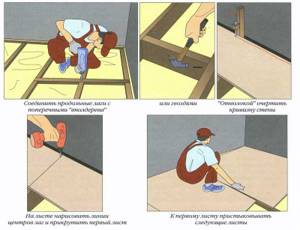
Stages of plywood flooring.
True, there is one condition here - you cannot use plywood in very wet rooms. Explanations for this were given above.
To check the humidity with your own hands, you need a simple sheet of polyethylene with dimensions of approximately 100 by 100 cm. It is simply placed on the floor and pressed tightly along the edges, leaving the center free. The polyethylene is left in this position for 2-3 days. Then they look at the inside. If there are drops of moisture, then the humidity is high, if there is just evaporation, then the humidity is average, if the polyethylene remains dry, then the humidity is low.
If all conditions are met, you can begin installation. It must be said that plywood on a wooden floor does not require any other insulation.
So, the plywood sheets are laid in a checkerboard pattern. As in the case of a concrete floor, a gap of 1-2 cm must be left between the walls and plywood. In addition, the sheets themselves must also be located at a distance from each other.
In this case, it is recommended to use plywood with the same thickness as in the previous one, that is, 12 mm.
However, if the base is quite uneven, it is best to use sheets of material with a thickness of 15 mm. If the floors are level, in order to save money, it is permissible to use sheets with a thickness of only 8-10 mm.
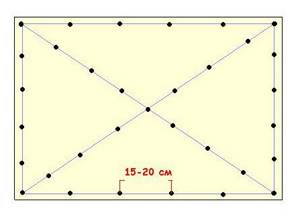
The plywood is fastened with self-tapping screws at a distance of 15-20 cm.
As for the material itself, it is better not to lay it in whole sheets. They are cut into squares with a side of 50-60 cm. By placing them at a distance of 1-2 mm, between each other, an optimal supply of damping seams is created. In addition, small sheets are much easier to work with.
There are some recommendations for floor preparation. It must be cleaned of dust, debris and foreign objects. The best option would be to cover the entire surface with a primer.
Fastening plywood can be done in two ways:
- using glue;
- on self-tapping screws.
The second option is naturally simpler and faster. Self-tapping screws are screwed into each corner and diagonally. The distance between them should be about 15-20 cm. In this case, they need to be screwed in so that the caps are slightly recessed.
Self-tapping screws should not be closer to the edge than 2 cm. Their length is taken based on 3 times the thickness of the sheet.
https://youtube.com/watch?v=V-2ziX6qXfc
After the sheets are completely laid, the entire surface is sanded. Then it is removed and puttied. It is only necessary to putty the places where the screws are attached. In this case, you need to use a special wood putty.
After all these procedures, the entire surface is varnished.
In the case where plywood acts as a subfloor, it is not necessary to sand, putty or varnish it.
Which side should you put penofol on the floor?
When laying thermal insulation, the problem of choosing the direction of installation often arises. Lay penofol on the floor with the foil side up. If double-sided material is used, then there is not much difference.
Another thing is how to form thermal insulation; the quality of floor insulation depends on this. You can, of course, simply lay penofol under the linoleum on a concrete floor. With a sheet thickness of 10 mm, the level of thermal insulation efficiency is 1/3 - 1/4 of penoplex or mineral wool 50 mm thick. For a high-rise apartment, or if the house uses radiant heating, this will be more than enough.
In other cases, it is necessary to do combined thermal insulation of the floor; only in this case can the maximum insulating effect be obtained.
Pros of using penofol
It is important to know all the positive aspects of using this material:
- It can be laid in rooms where it is damp, for example, in a cellar (basement). When laying, separate membranes for waterproofing are not required.
- In addition to the fact that you get a coating that retains heat well, sound insulation is a bonus. This quality of material is relevant for multi-storey buildings with noisy neighbors.
- Penofol is recommended to be used in combination with other heat insulators, then its properties only increase. A good example is the use of the desired material in baths. A layer of aluminum foil in the steam room helps keep the temperature high.
- Even at high humidity and high temperatures, penofol will not emit fumes that could harm human health.
- The material is considered thin, which is good when laying it on the ceiling. The height of the ceilings practically does not change; other insulation materials make the room visually smaller, since they recede a few centimeters from the ceiling.
- Penofol is offered for sale in rolls. It can be easily cut and you can lay it down in a short period of time.
- It is often used in areas where there is a high fire hazard. The material does not burn, which makes it irreplaceable.
- For private houses, it is used to insulate the basement floors, and also because mice do not gnaw on it.
Advantages and disadvantages of penofol
The main advantages of the material:
- Low ability to conduct heat. The thermal conductivity index can vary between 0.039-0.051 W/(m*C).
- The vapor permeability level is 0.01 mg/(m*hour*Pa).
- The heat reflection rate can be over 97%.
- Excellent sound absorption performance.
- Penofol does not absorb moisture, the moisture absorption rate is less than 1%.
- At elevated temperatures, the material is not subject to melting (up to 1100 C).
- Differs in small sheet thickness.
- Durable, resistant to mechanical stress and has a long service life.
- Very easy to install.
- Has an affordable price.

The density of penofol can vary from 25 kg/m³ to 50 kg/m³. If penofol is used in combination with other types of insulation, its effectiveness increases significantly.
Disadvantages of a heat insulator:
- Insufficient level of rigidity. It is not possible to paste wallpaper or paint it on top of insulation boards.
- When fixing penofol, it is necessary to provide protection for the electrical wiring and you will need to beware of breakdowns.
- Low level of adhesion. In order to obtain reliable adhesion to the insulated surface, you will need to use a special adhesive mixture or use dowel-nail fastening.
Insulation of walls from the inside
Insulating walls with this insulation is easy to do with your own hands. To do this you will need:
- penofol;
- thin pieces of wood for the frame;
- additional insulation for electrical wiring (if necessary);
- nails or screws, respectively, a hammer or screwdriver;
- sheathing
Step-by-step description of the process:
- At the initial stage, a frame is constructed from thin wooden blocks. In this case, a distance of 2 cm from the penofol to the surfaces should be maintained. The air layer will enhance the effect of the insulation.
- Then, using a special glue, the material is glued to the frame. Rarely, not in all cases, you can use a construction stapler for fastening. This method is possible when insulating a balcony.
- Provide additional insulation for wiring if required. And this is required in the case when the electrical wiring is laid behind the insulation, because penofol with a layer of foil conducts current well and can lead to unpleasant consequences.
- Then you need to assemble another frame, which will be about 2 cm thick. And the necessary sheathing is attached to the second frame.
Tools and materials for floor insulation
To insulate the floor of a house or cottage with penofol, you will need the following tools :
- crowbar;
- hammer;
- painting knife for cutting material;
- level;
- screwdriver
Materials required for the work:
- penofol sheets;
- plywood;
- self-tapping screws;
- glue.
In conclusion, we can say that penofol is often used to insulate floors, since due to its special properties it increases heat transfer resistance . In this case, there is no need to additionally use hydro- and vapor barrier, since the material combines these functions and can be used in conjunction with mineral wool or fiberglass.
Technology and features of floor insulation from below in a wooden house
For each type of insulation, there are some specific features of use.
Mineral wool
The sizes of rolls and slabs are usually multiples of 60 cm, which makes this distance the optimal step between the logs. Mineral wool is cut to size with a cutter and placed in the space between the joists. For a tight fit, the size should be 1–2 cm larger than the distance between the joists. Cotton wool should not be pressed down forcefully as this may affect its characteristics.
The best option would be to lay two layers of insulation. The second layer is laid so that the joint of the lower layer falls on the center of the upper piece. This method of installation will prevent cold air from entering the room.
Penoplex and foam plastic
If foam plastic is used when insulating a wooden floor from below in a private house, you must take into account several rules for working with it:
- Foam absorbs water, so waterproofing is required. Many experts do not take this property into account during installation, which leads to a decrease in thermal insulation characteristics.
- It is recommended to cut the sheets not exactly to the size of the gap between the joists, but 1–2 cm smaller. This will allow you to fill the gaps between the sheet and the joist with polyurethane foam, which will increase the thermal insulation properties. The joints between the sheets also need to be foamed.
Sheets can be fastened using slats, spacer wedges or special adhesives.
Floor insulation with foam plastic in a wooden houseSource sk-amigo.ru
The principle of working with penoplex is no different. But due to the smaller thickness of the material, it can be laid with overlapping sheet joints to avoid the formation of cold islands (similar to mineral wool).
But this method significantly increases material consumption, which means additional financial costs.
Penofol
Due to its property of not allowing moisture to pass through, penofol does not require additional installation of vapor and waterproofing. But to prevent the water vapor that forms in the room from settling on the insulation layer, an air gap is needed between it and the flooring for air circulation.
Laying is done with the foil side up only. This will allow heat to be reflected, which will increase the temperature in the house. Penofol can be used as waterproofing when laying mineral wool or polystyrene foam. This can increase thermal insulation several times, but this method is quite expensive.
Penofol joints are sealed with adhesive tapeSource build.4-u.info
The material is sold in rolls and can be easily cut into pieces of the desired size. Fastening is carried out with a construction stapler on staples or with thin slats that are nailed. To improve the result, it is recommended to lay penofol in several layers.
One of the main problems of wooden houses is cold floors, which interfere with a comfortable life and increase heating costs. Proper insulation will solve this problem. Regardless of the material that is chosen for insulating the finished floor in a wooden house from below, it is necessary to strictly follow the general technology and procedure for insulation, as well as take into account the features of a particular insulation. The cost of installing insulation pays off within one season.
How can you insulate a wooden floor using penofol?
Older private homes usually have wood floors. Over time, they begin to retain heat poorly, and the room becomes cold. It is especially difficult for residents in the autumn and winter periods. There is a simple method to correct the current situation with the floor. It is possible to insulate a wooden floor with penofol without opening it. Thermal insulation material is laid on top. It turns out that the layer is located on top of the wooden floor. It is placed end to end. It is important not to forget that the seams must be sealed with special aluminum tape.
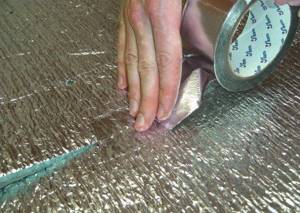
The resulting layer is covered with sheets of plywood. Thermal insulation is attached to the wooden base using self-tapping screws.
Insulation of a wooden floor with penofol from below occurs by raising the upper boards. It is preferable to remove the old covering from the boards and put several layers of covering between the joists. The material must be laid with the foil down. After this, the old coating is returned to its place.
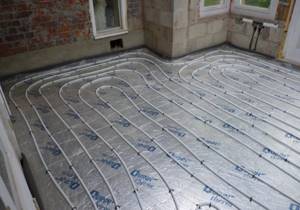
Insulating the floor from below with penofol is a convenient way to work with this material. The floors will definitely become warmer.
Features of floor insulation work with Penofol
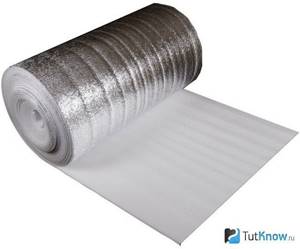
Penofol is a combined material made of foamed polyethylene and aluminum foil with a thickness of 4-10 mm. It prevents heat loss in three directions - through convection, conduction and in the infrared spectrum.
Most other insulators have only one of these properties. This means that a thin sample can replace insulation materials of much greater thickness. There are several modifications of polyethylene foam, which differ in the placement of aluminum foil on one or both sides and the presence of an adhesive layer.
The scope of use of the material is quite wide. It does not have pores and does not allow air to pass through, so it is often used to insulate the floors of saunas and baths. The product copes with the insulation of concrete and wooden flooring. Penofol is also present in the structure of heated floors.
Installation of insulation is always carried out on the sheathing. It is necessary to create a gap above the foil. The air passing through it will remove accumulated moisture.
In most cases, Penofol is used with other insulation materials. It interacts well with polystyrene foam, penoplex, mineral wool and other products. It is also used as an independent heat insulator.
Which penofol is best to use for floor insulation?
There are several brands of sheet material with foil on the market that are used for thermal insulation. You should not rush to buy the first penofol you come across, since not all types of sheet foam polyethylene are equally good for floor insulation. An exception may be the situation with the installation of an insulating layer on an open balcony area or even a loggia. In this case, you can insulate the floor on the balcony with penofol of any brand, the main thing is to correctly cut the material and lay it in the base.
Main brands of penofol
On sale you can most often find material in three size groups: 4 mm, 8 mm and 10 mm. This division allows you to more accurately select the overall thickness of the thermal insulation. You can buy specialized material used in industrial construction. In this case, the thickness of the penofol sheet can reach 15-24 mm.
Penofol has two close relatives - Armofol and Olefol. In the first, aluminum foil is reinforced with a layer of fiberglass or mesh, due to which the thermal insulation layer is able to withstand constant heating up to 200 o C. Olefol has an additional layer of waterproofing.
Penofol is available in several modifications:
- Type A - foamed polyethylene with one side covered with aluminum foil. Suitable for thermal insulation of the floor of any residential premises;
- Type B - the same penofol, with closed pores and double-sided foil coating, called a thermal barrier;
- Type C – one-sided aluminum coating and an adhesive layer on the base side. Used for thermal insulation of problematic and unstable floors;
- The “Super NET” type is a variation of the previous three brands of penofol, but with additional reinforcement of the structure with an imprinted mesh. Due to its high strength, penofol can be used for thermal insulation of loaded structures. For example, insulate the floor with penofol in a wooden house directly on the back side of the floorboards;
- Type “A-LP” – closed-cell polyethylene foam with aluminum foil covering. The aluminum surface is additionally protected with polyethylene film;
- The “AIR” type has high strength and good waterproofing properties.
The latter option is often used for noise protection and thermal insulation of air ducts and air conditioning systems. One fabric combines the qualities of both waterproofing and the ability to insulate the floor.
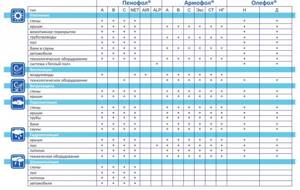
The specific type of material for foam insulation from the bottom of the floor will need to be selected based on the design of the base and the general structure of the house. For a simple wooden floor in an apartment, it is best to insulate it with sheet material with an air gap.
The main competitors of penofol in thermal insulation
Craftsmen and managers of construction salons often suggest using cheaper materials based on polyethylene foam. These can be Izolon, Polyfon, Stizol and a host of other thermal insulation coatings from well-known and unknown manufacturers. Almost all of them have a coarse-cell structure, and in terms of characteristics and quality of thermal insulation they are only slightly inferior to penofol.
They cost less, but there are certain differences from penofol:
- Most substitutes do not have a full coating of aluminum foil; a thin metallized film is sprayed on the surface of polyethylene foam;
- Softeners and fire retardants have been added to penofol, which, as a rule, is not the case with competitors.
As a result, upon contact with an open fire, polyethylene foam ignites briefly and dies out fairly quickly. Competitors burn completely, even without contact with the flame front.
You can check the characteristics of the material yourself on a small sample using a lighter. If the foamed polymer burns without a residue, then it is clearly not penofol.
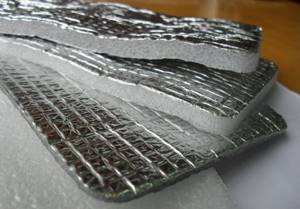
In high-quality penofol, aluminum foil can be felt by hand
